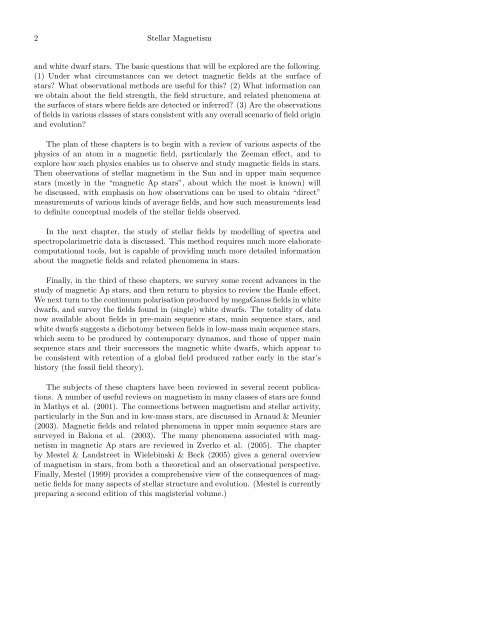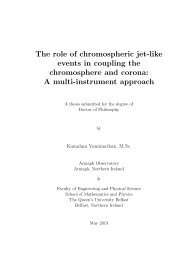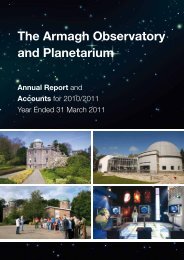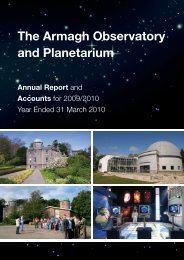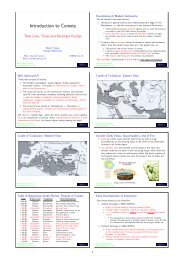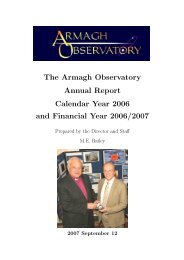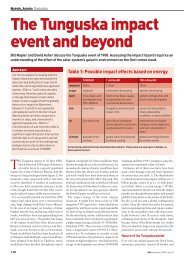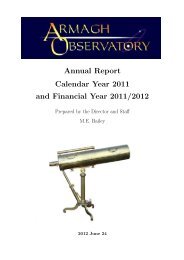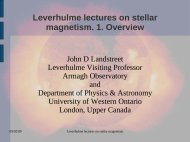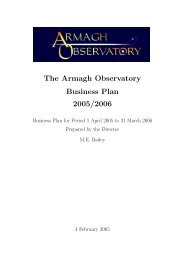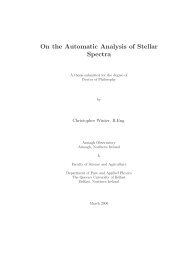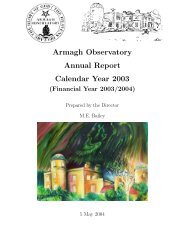OBSERVING AND MODELLING STELLAR MAGNETIC FIELDS ...
OBSERVING AND MODELLING STELLAR MAGNETIC FIELDS ...
OBSERVING AND MODELLING STELLAR MAGNETIC FIELDS ...
Create successful ePaper yourself
Turn your PDF publications into a flip-book with our unique Google optimized e-Paper software.
2 Stellar Magnetismand white dwarf stars. The basic questions that will be explored are the following.(1) Under what circumstances can we detect magnetic fields at the surface ofstars? What observational methods are useful for this? (2) What information canwe obtain about the field strength, the field structure, and related phenomena atthe surfaces of stars where fields are detected or inferred? (3) Are the observationsof fields in various classes of stars consistent with any overall scenario of field originand evolution?The plan of these chapters is to begin with a review of various aspects of thephysics of an atom in a magnetic field, particularly the Zeeman effect, and toexplore how such physics enables us to observe and study magnetic fields in stars.Then observations of stellar magnetism in the Sun and in upper main sequencestars (mostly in the “magnetic Ap stars”, about which the most is known) willbe discussed, with emphasis on how observations can be used to obtain “direct”measurements of various kinds of average fields, and how such measurements leadto definite conceptual models of the stellar fields observed.In the next chapter, the study of stellar fields by modelling of spectra andspectropolarimetric data is discussed. This method requires much more elaboratecomputational tools, but is capable of providing much more detailed informationabout the magnetic fields and related phenomena in stars.Finally, in the third of these chapters, we survey some recent advances in thestudy of magnetic Ap stars, and then return to physics to review the Hanle effect.We next turn to the continuum polarisation produced by megaGauss fields in whitedwarfs, and survey the fields found in (single) white dwarfs. The totality of datanow available about fields in pre-main sequence stars, main sequence stars, andwhite dwarfs suggests a dichotomy between fields in low-mass main sequence stars,which seem to be produced by contemporary dynamos, and those of upper mainsequence stars and their successors the magnetic white dwarfs, which appear tobe consistent with retention of a global field produced rather early in the star’shistory (the fossil field theory).The subjects of these chapters have been reviewed in several recent publications.A number of useful reviews on magnetism in many classes of stars are foundin Mathys et al. (2001). The connections between magnetism and stellar activity,particularly in the Sun and in low-mass stars, are discussed in Arnaud & Meunier(2003). Magnetic fields and related phenomena in upper main sequence stars aresurveyed in Balona et al. (2003). The many phenomena associated with magnetismin magnetic Ap stars are reviewed in Zverko et al. (2005). The chapterby Mestel & Landstreet in Wielebinski & Beck (2005) gives a general overviewof magnetism in stars, from both a theoretical and an observational perspective.Finally, Mestel (1999) provides a comprehensive view of the consequences of magneticfields for many aspects of stellar structure and evolution. (Mestel is currentlypreparing a second edition of this magisterial volume.)


